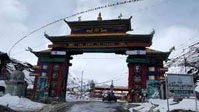Masud Ahmad Khan
The Sino-Indian border is divided into three sectors. The western sector is known as Aksai Chin sector, the central sector where China shares a border with Uttarakhand and Himachal Pradesh and the eastern sector comprises the states of Arunachal Pradesh and Sikkim—the largest disputed area covering around 90,000 square kilometers. Arunachal Pradesh (south Tibet) has 63 percent of its population belonging to faiths other than Hinduism. The state contains the highest proportion of Buddhists in India and it was also known as North East Frontier Agency (NEFA), a term coined by the British. However, India renamed
it Arunachal Pradesh and made a state from the union territory.
In 1914, Tibet and Britain negotiated a treaty and Sir Henry McMahon, the foreign secretary of British India at that time, drew the 550 mile (890 kilometer) McMahon Line as a border between British India and Tibet. The Tibetan and British representative at the convention agreed to the line which ceded Tawang and other Tibetan areas to British India. China, not being a signatory to this agreement, objected to the validity of line. Until 1935, the McMahon Line was forgotten; it was only activated when the British published the 1937 edition of Aitchison’s collection of treaties. The demarcated line is called
the Line of Actual Control (LAC) which China did not recognise. The pretext of the 1962 war, besides the Dalai Lama, was a dispute over the sovereignty of Arunachal Pradesh and Aksai Chin while the 1962 skirmishes turned provoked war as well. The Indian army proved to be too weak to fight the Chinese army and after heavy losses, they escaped towards Bhutan. During the war the entire Arunachal Pradesh was occupied by the Chinese army, who came down till Tezpur, Assam. In his book, ‘Avoiding Armageddon’, Bruce Riedel writes, “India was humiliated, Nehru was devastated. Driven Indians from
the east and even Calcutta was at risk. Nehru was so desperate and requested the US to rescue them”.
After the war, while declaring victory, China voluntarily withdrew. After the 1962 war, India went forward to areas of Arunachal Pradesh and started patrolling the border. In 1984 India established an observation post on the bank of the Sangduolue He and resultantly, the Chinese also moved their forces in the area. India, in a major military push through operation Falcon, airlifted a mountain division of the army to the borders. In the disputed region, India also carried out another exercise Chequerboard—an air and land exercise to further strengthen their positions all across the Himalayan region. By 1987, the
Indian army deployed 11 divisions in the region backed by paramilitary forces as opposed to the 15 Chinese divisions. The successive Chinese government never recognised Arunachal Pradesh as a state of India. China always opposed the Indian politicians’ visit to the state.

